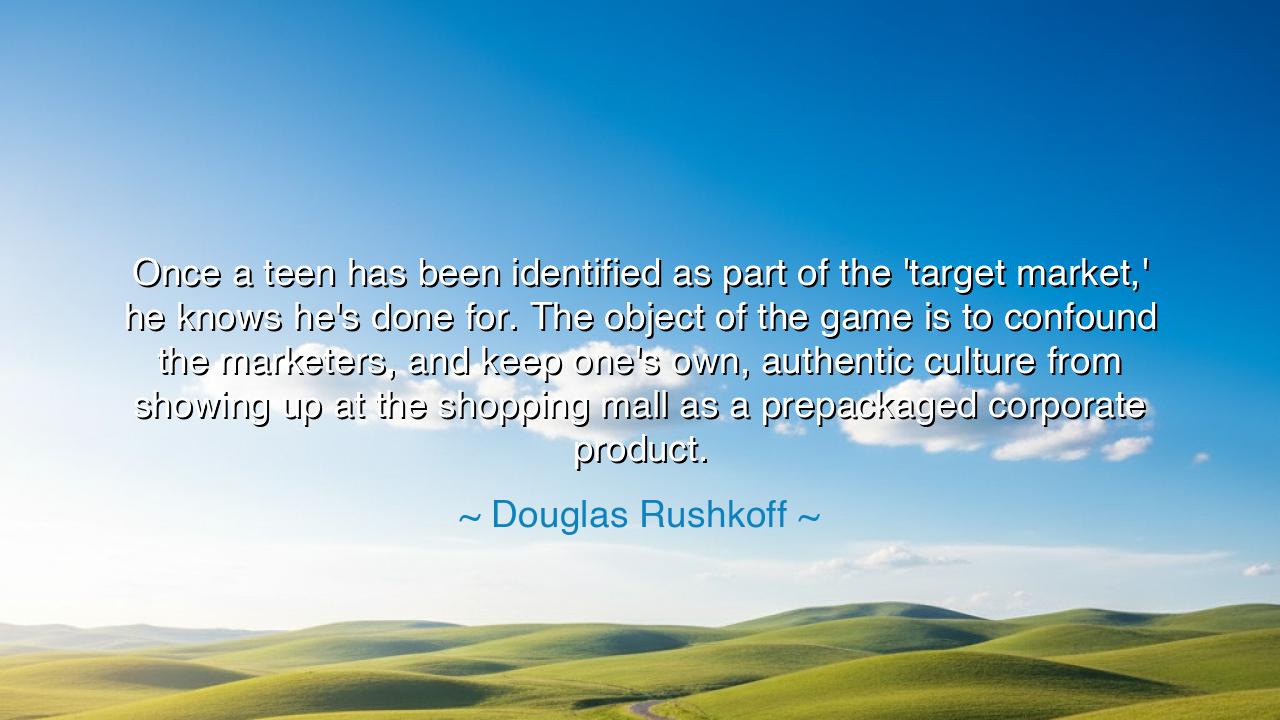
Once a teen has been identified as part of the 'target market,'
Once a teen has been identified as part of the 'target market,' he knows he's done for. The object of the game is to confound the marketers, and keep one's own, authentic culture from showing up at the shopping mall as a prepackaged corporate product.






Douglas Rushkoff, a keen observer of media and culture, once declared: “Once a teen has been identified as part of the ‘target market,’ he knows he’s done for. The object of the game is to confound the marketers, and keep one’s own, authentic culture from showing up at the shopping mall as a prepackaged corporate product.” These words ring like a warning bell to the young, for they reveal the struggle between authenticity and commodification, between the raw vitality of youth culture and the relentless machinery of consumerism.
The meaning of this quote lies in the realization that when the spirit of youth becomes merely a “target market,” its originality begins to die. For youth culture is born in rebellion, creativity, and self-expression. It thrives in music created in garages, in styles crafted from thrift stores, in languages whispered on street corners. But when corporations seize these living forms and repackage them into products for profit, what was once alive becomes a hollow shell. The teen, once creator, becomes consumer, and the fire of authenticity is smothered by the cold weight of profit.
The origin of Rushkoff’s reflection lies in his study of media and advertising in the late 20th century. During this time, corporations increasingly studied teens as valuable markets, probing their slang, their fashions, their music, and their rituals. Youth, which had once naturally birthed movements like punk or hip-hop, suddenly found itself mirrored in commercials, clothing lines, and mass-produced soundtracks. The underground was dragged into the fluorescent lights of the shopping mall, and what was once authentic became another “brand.”
The ancients, too, understood the danger of spirit being overtaken by imitation. Consider the philosopher Diogenes, who scorned the polished conventions of Athenian society and chose to live simply in a barrel, mocking the hollow pursuit of wealth. He sought to preserve what was authentic against the flood of pretension. So too do Rushkoff’s words call to the youth: protect your soul, resist the reduction of your culture into something sold back to you in boxes, slogans, and jingles. For when your rebellion is mass-produced, it ceases to be rebellion at all.
History gives us the example of the hip-hop movement, born in the Bronx in the 1970s out of poverty, oppression, and raw creativity. At first, it was authentic expression: breakdancing in the streets, graffiti on the walls, rhymes shouted over beats as a cry of identity. Yet as corporations realized its power, they co-opted it, turning it into a commodity. What was once a cry of defiance became in many corners a marketing strategy. The youths who began it did not intend it to end up in advertisements for sneakers or soda, but such is the fate of culture when it is captured by the marketplace.
The lesson here is clear: to preserve authenticity, one must remain vigilant against the forces of commodification. The game, as Rushkoff says, is to confound the marketers—to stay unpredictable, to resist the flattening of your voice into a product. True culture must remain alive, breathing, resistant to being caged in glossy packaging. This requires courage, for the lure of recognition and profit is strong. But the soul of youth is meant to be wild, not domesticated.
Practical wisdom flows from this: if you are young, guard your creativity. Do not let it be stolen, diluted, and resold to you. Create not for profit, but for expression, for truth, for connection. If your style is imitated, change again. If your music is absorbed, find a new rhythm. Stay one step ahead of the machine, and keep your culture alive by refusing to let it be bought. In this way, you preserve what is sacred and refuse to let your spirit be packaged.
So, children of tomorrow, heed Rushkoff’s teaching: you are not a market, you are a creator. Do not allow your culture to be swallowed by corporations and sold back to you. Keep it free, keep it alive, keep it yours. For when authenticity is preserved against the claws of commodification, the soul remains untamed—and in that wildness lies both truth and power.






AAdministratorAdministrator
Welcome, honored guests. Please leave a comment, we will respond soon